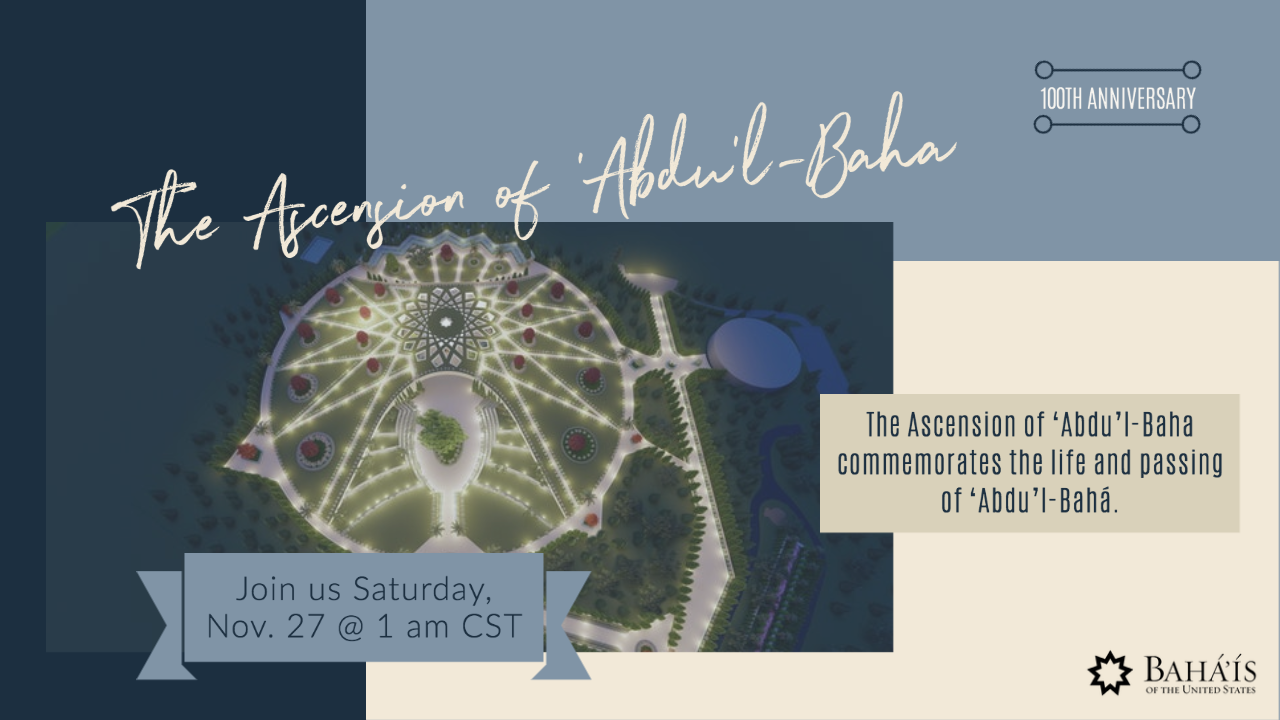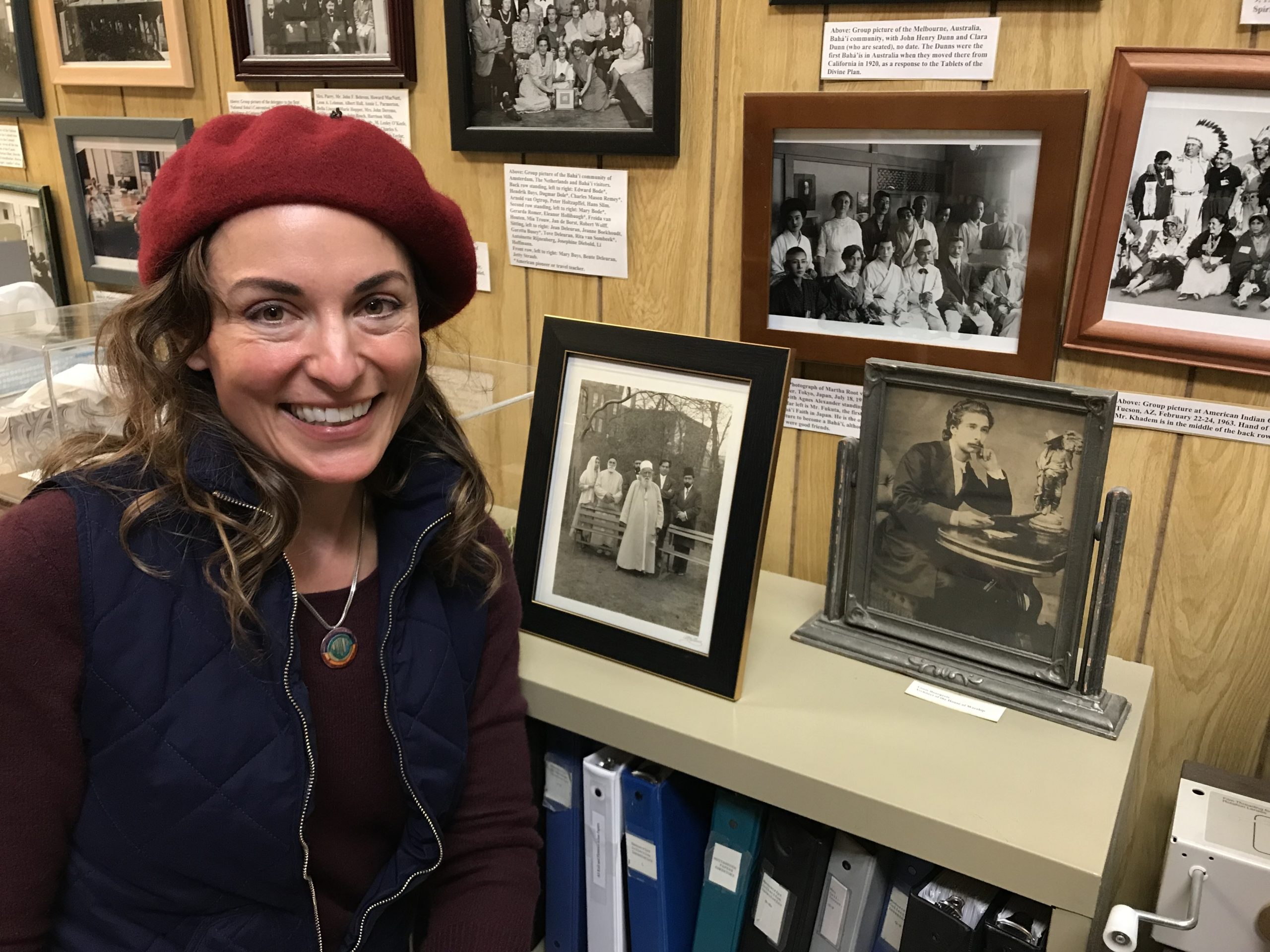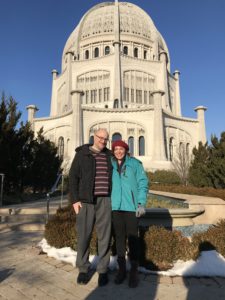



By Jeremy Lambshead
Christy Harvey has pondered questions about sacred spaces for decades. She recently visited, for the first time, an innovative sacred space: the Baha’i House of Worship in Wilmette, Illinois.
As it happens, this structure—which is architecturally unique in the world and history—was designed by Harvey’s great-great-grandfather, Louis Jean-Baptiste Bourgeois.
Harvey learned of her ancestral connection to this world-renowned architect as an adult, and after years of wanting to visit the Baha’i Temple, she was finally able to do so thanks to a birthday gift from her partner, Tim Berard. The two live in Cleveland.


“Love and grace are primary values for me in my life,” Harvey says. “I don’t see how Louis could have created the Temple and designed it without heaping amounts of love and grace. In the Temple, that universal love just feels so pronounced.”
Harvey says she was touched by the warm welcome she received from staff and guides who admire Bourgeois and were excited to meet his great-great-granddaughter. “I loved feeling so embraced by kindred spirits,” she says.
Harvey and Berard toured the Welcome Center and grounds and learned details about the Temple and its architect. They saw some of Bourgeois’ drawings and artifacts. Bourgeois based his design on guidelines given by ‘Abdu’l-Baha, the son of Baha’u’llah and head of the Baha’i Faith at the time. All Baha’i houses of worship follow the same pattern of having nine sides and a dome, symbolizing that people come from all directions under the embrace of a single God.
Harvey says she felt a strong connection to Bourgeois and discovered profound similarities between the two of them. For one, she says that being in the Temple made her feel that the two were “on the same team around creating sacred space. He just managed to do that in a very physical sense that is awe-inspiring. I do that more with a different kind of space, but the intention is there,” she says.
In her work as a therapist, counselor and life coach, Harvey says she holds sacred space for people in the figurative sense, by creating safe, supportive, non-judgmental atmospheres where others can “heal and create their best lives.”
Specifically Harvey values round spaces: “There is something really supportive of wholeness, of connectivity, of more of a sense of union, when it’s in the round.”
At one point, she worked for a global construction company whose buildings incorporate spiritual principles into design and architecture—including a domed space. Recently she worked in an office shaped like an octagon. The nine-sided design of the Baha’i House of Worship made her feel right at home.
This attraction to round spaces seems to extend to Harvey’s daughter, Amara. At 20 months old, when asked what kind of house she’d like to live in, Amara drew a large octagon on a piece of paper, put it on the floor, stepped inside the shape, and announced in toddler-speak, “oc-a-gon.”
Harvey says she also relates strongly to the way Bourgeois received and applied his artistic inspiration. He designed models of the House of Worship at a time when there was no known technology capable of implementing the structure he envisioned.


Nevertheless, he persevered with faith. Later, innovative application of precast concrete enabled Bourgeois’ design to be actualized.
Harvey says she has taken a similar approach in her life: “When the universe gives us assignments and we’re working on the manifestation, what I see over and over and over is that the right resources show up at the right times.”
Another commonality between the two is their approach to work, which in both cases resembles the Baha’i teaching that “Work done in the spirit of service is the highest form of worship”.
For many years, Bourgeois was utterly devoted to designing and overseeing the construction of this “Temple of Unity,” and pursued that work as his life’s central purpose.
Similarly, Harvey reflects that “when I’m working with people or when I’m writing or creating in some way, that’s the devotion. It isn’t something separate where I would stop those activities in order to go worship in prayer.”
Harvey says there is a “spiritual or soul-based genealogy” that she inherited from her great-great-grandfather as well: traits such as kindness, depth, spirituality, “looking out for other people,” and “a certain soulfulness and desire for serving humankind.” Harvey says that discovering all these commonalities infused her visit with a feeling of “coming home.”
In learning about the Baha’i Faith, Harvey discovered that she agrees with many Baha’i teachings, which have long seemed self-evident to her, but which she never thought of as fitting within a particular religion.
“This has been really interesting and gorgeous,” she says, “this not only acceptance, but embracing of the different world religions.”
In her work, Harvey says she has noticed that her clients, who hail from diverse faith backgrounds, have shared similar experiences about the feelings of peace and love that result from practicing their faith.
“It’s all about the oneness and love,” she says. “That gets me every time I think about it—makes me cry—just knowing that Louis really got that, and of course, the Baha’i Faith is exemplifying this.”
While Harvey was in the Temple’s Auditorium, she experienced something which she says felt unique: “It was that earnest, prayerful presence of all kinds of races and languages and ages. And it was beautiful—absolutely stunning.”
She says she also felt she made a deep connection with Bourgeois, and by extension, with the rest of her lineage: “It’s like messages from him that were coming through, around wholeness and perfection—both at a very personal level, as well as for humanity.”
Reflecting on her overall experience of visiting the Baha’i House of Worship and learning more about her ancestor at this time in her life, Harvey says, “There’s a deep knowing that we’re in this together. Even though sometimes it looks a little scary out here, there’s generation behind generation behind generation supporting us, as well as the unseen bringing gifts of insight and inspiration.”


![]()
![]()
Whether you are exploring the Bahá'í Faith or looking to become an active member, there are various ways you can connect with our community.
Please ensure that all the Required Fields* are completed before submitting.